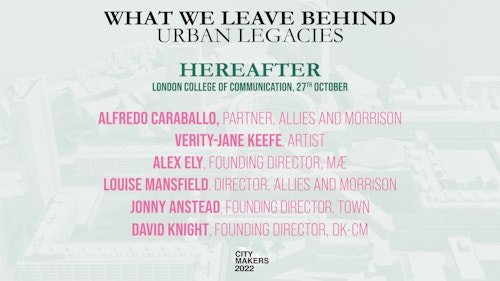/ Citymakers - What we leave behind, Urban Legacies: Hereafter
How should we retrofit and adapt post-war estates and suburbia for the climate emergency?
The second session in 2022’s Citymakers series, brings the conversation from high-level observations and approaches down to ground level. As day one reexamined architectural inheritance, day two takes a more focused look at two models of housing; suburbia and the modernist estate. It was held at the London College of Communication, a mid-century building which Allies and Morrison has visited before as architect, and will soon make way for an entirely new building, now onsite.
Alfredo Caraballo begins with a compelling framing of two socially entwined typologies: the slab and the suburb. These modern urban patterns are found around the world, even visually colliding as Alfredo shows in his home town of Caracas, Venezuela. He argues they have the same genealogy, the same balance, both emerging from the preoccupations of late 19th century and early 20th century life of urban population growth and an increasing awareness of health. We have these two models that relate in their ambitions, in relation to space and are problematic in different ways; Alfredo asks, in which way can we intervene?
Verity-Jane Keefe shares her work in Becontree and Thamesmead (two outer London suburbs shaped in the 20th century) over a number of years as artist in residence. Working predominantly in the public realm with moving image and installation-based work, Verity describes her interest in the role of the artist within a regeneration context, getting to the root of a place, and the importance of truly understanding the lived experience from the residents’ perspective. Verity raises questions of how to disrupt spaces positively, interrogating the notion of ‘public’ and challenging preconceptions of architectural value and taste.
Alex Ely, Founding Director of Mæ, reminds us that we’re demolishing around 50,000 buildings every year in the UK, which accounts for 63% of the nation’s waste. With flexible thinking at the fore, Alex shares his practice’s response to three modernist estates, illustrating the hidden value of these sometimes awkward structures when adapted with context and creativity.
Louise Mansfield, takes us on a historical journey of Harlow through the eyes of the modernist polymath, Frederick Gibberd. Seizing on the mood of the moment in a meeting of principles; the preoccupation for light and space with a suburban scale, these first ‘new’ towns were part of a pioneering phase of post-war suburban development. Louise shares the challenges faced today for these once optimistic places, and how urban design might offer the practical solutions to imbue them with a new lease on life.
Drilling down to the root of the suburban offering, Jonny Anstead, Founding Director of developer, TOWN, offers a fascinating insight into a Cambridge co-housing development, Marmalade Lane. This quietly radical scheme may offer a new way of living in this context, in a world fearful of challenging the suburban status quo. Jonny describes how the scheme subverts intrinsic notions of privacy, car dependency and land use orthodoxy so familiar in this typology. Might this be the start of a new suburban future?
David Knight, Founding Director of DK-CM, introduces the idea of small projects as a way to intervene in the legacies and ruins of past public ideas, to reinvent them for the way we live today. Finding new purpose in these forgotten relics of public life, David demonstrates the use of public realm as mediation between public buildings and the private suburban sphere in which they find themselves. Using the stories of a public swimming pool in a suburb of Barkingside, a public toilet in Tottenham and a former shoe shop in Westminster, to question how we transform our civic inheritance for the future.

